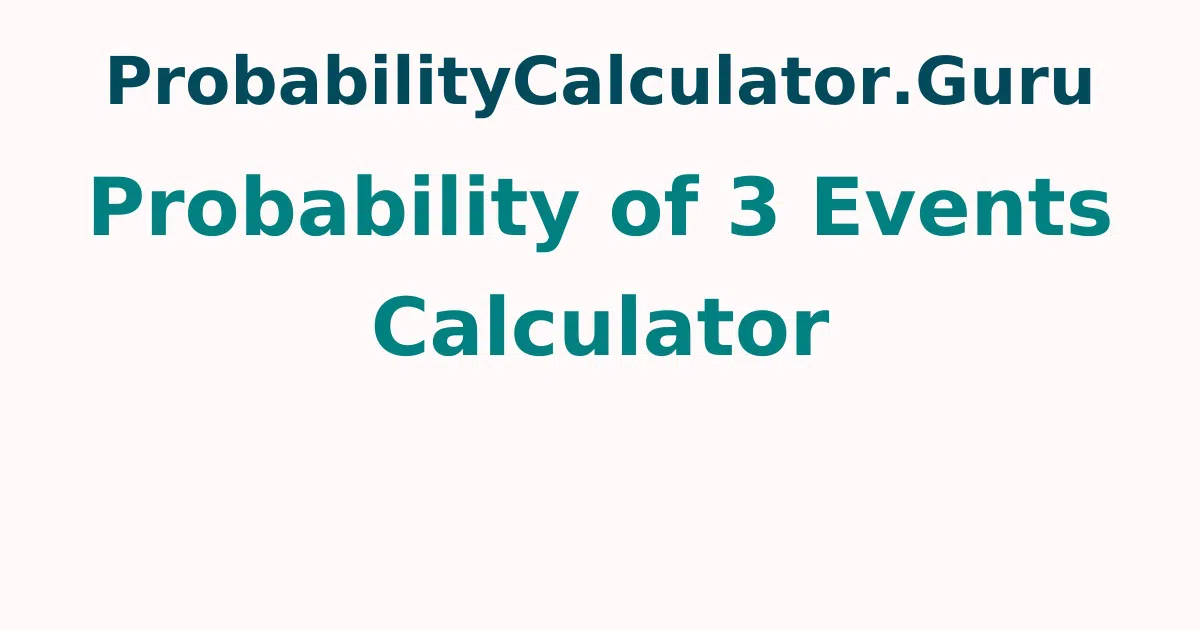Probability of 3 Events Calculator
Created By : Vaibhavi Kumari
Reviewed By : Phani Ponnapalli
Last Updated : Apr 02, 2023
Utilize the handy Probability of 3 Events Calculator to quickly find out the Probabilities of three events A, B, C in a matter of seconds. Simply provide the probabilities of all three events in the boxes below and then tap on the calculate button to avail the resultant probabilities in different cases in no time.
Probability of Three Events Calculator
You can use our Probability of 3 Events to determine any of the following. They are outlined for your reference as such
- Probability of at least one event out of three occurring (union of three events i.e. P(A ∪ B ∪ C))
- Probability of the intersection of three events (all three happening i.e. P(A ∩ B ∩ C))
- Probability of exactly one event happening(P(A ∩ B' ∩ C') + P(A' ∩ B ∩ C') + P(A' ∩ B' ∩ C))
- Probability of none of them occurring(P(∅)).
Probability Rules
Have a glance at the basic rules of probability below and enhance your subject knowledge on the concept so that you may find them useful in your problem solving. The fundamental probability rules are explained below
- Addition Rule: This particular rule applies if event is the outcome of union of two other occurances. For instance, if you have two events say A and B then we can write it as P(A ∪ B) = P(A) + P(B) – P(A ∩ B)
- Complementary Rule: This rule can be applied when one occurence is counterpart of the other. If you have an event A then the rule is as such P(A') = 1 - P(A)
- Conditional Rule: We will apply this rule when we have partial information about occurence of an event. For Example if an event A is already happened and probability B is sought the rule is as follows P(B, given A) = P(A and B)P(A)P(B, given A) = P(A and B) / P(A)
- Multiplication Rule: This rule can be applied anytime an event occurs at intersection of two additional events. P(A ∩ B) = P(A) × P(B) for independent events.
- Probability ranges between 0 and 1.
Understand the difficult concepts too easily taking the help of the online tools available at Probabilitycalculator.guru and clarify your doubts during homework or assignments.
How to find Probability of 3 Independent Events? | Probability of 3 Events Formula
Follow the step by step process mentioned below to determine the probabilities of three events manually by hand.
- Multiplication Rule: In order to determine the probability of intersection of three independent events then simply multiply the probabilities of all 3 events together i.e. P(A ∩ B ∩ C) = P(A) * P(B) * P(C)
- Addition Rule: To obtain the probability of atleast one event occuring out of three then sum the probabilities of three events and then subtract their intersections i.e. P(A ∪ B ∪ C) = P(A) + P(B) + P(C) - P(A ∩ B) - P(A ∩ C) - P(B ∩ C) + P(A ∩ B ∩ C) On Applying the multiplication rule formula we can get the probability of union of three events in terms of P(A), P(B), P(C) i.e. P(A ∪ B ∪ C) = P(A) + P(B) + P(C) - P(A) * P(B) - P(A) * P(C) - P(B) * P(C) + P(A) * P(B) * P(C)
To find the Probability of Exactly one Event Happening Or probability of exactly one event out of 3
- We will find the sum of probabilities of three scenarios i.e. A happens, B and C don't; B happens, A and C don't; and C happens, A and B don't i.e. P(A ∩ B' ∩ C') + P(A' ∩ B ∩ C') + P(A' ∩ B' ∩ C)
- By applying the multiplication rule we have the equation above as P(A ∩ B' ∩ C') + P(A' ∩ B ∩ C') + P(A' ∩ B' ∩ C) = P(A) * P(B') * P(C') + P(A') * P(B) * P(C') + P(A') * P(B') * P(C')
- We shall use the complement rule and obtain the formula which need P(A), P(B), and P(C): P(A) * P(B') * P(C') + P(A') * P(B) * P(C') + P(A') * P(B') * P(C) = P(A) * (1 - P(B)) * (1 - P(C)) + (1 - P(A)) * P(B) * (1 - P(C)) + (1 - P(A)) * (1 - P(B)) * P(C)
To calculate the chance that neither of the three events occur we wil apply the complement rule for opposite event, in which we have atleast one event happens P(∅) = 1 - (P(A) + P(B) + P(C) - P(A) * P(B) - P(A) * P(C) - P(B) * P(C) + P(A) * P(B) * P(C))
FAQs on Probability Calculator 3 Events
1. What is the range of Probability?
Probability ranges between 0 and 1.
2. How do you Calculate the Probability of 3 Events using a Calculator?
Conditional probability calculator 3 events or 3 event probability calculator, Simply enter the Probabilities of all 3 Events in the allotted boxes and click on the calculate button to avail the Probability in a matter of seconds.
3. What is the Formula for Probability of Union of Three Events?
The Formula for Probability of Union of Three Events OR probability of union of 3 events is P(A ∪ B ∪ C) = P(A) + P(B) + P(C) - P(A ∩ B) - P(A ∩ C) - P(B ∩ C) + P(A ∩ B ∩ C).
4. Where do I get Probability of Three Events Calculator for free?
You can get Probability of Three Events Calculator for free on probabilitycalculator.guru a trusted and reliable portal.
